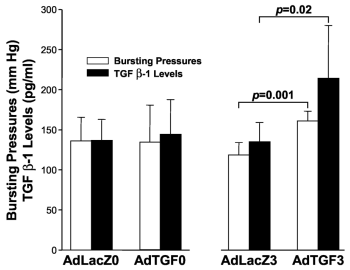# 104141 Abstract ID: 104141 Effect of Adenoviral-Mediated Transfer of Transforming Growth Factor ▀-1 (TGF ▀-1) on Colonic Anastomotic Healing
John Migaly, Jonathon Lieberman, Walter Long, Rolando Rolandelli, Philadelphia, PA
PURPOSE: TGF ▀-1 plays a central role in colonic repair. We examined the temporal effect of vector-mediated transfer of TGF ▀-1 on colonic anastomotic healing. METHODS: Sprague-Dawley rats (n=24) underwent transection of the distal colon and single-layer anastomosis. Proximal to the anastomosis, the colon was again transected and a colostomy was matured proximally; the distal colon was intubated with a silicone catheter, tunneled along subcutaneous tissues and connected to a swivel apparatus for luminal infusion. Rats were randomized into four groups (n=6 each): a group received 1010 pfu of a Type 5 E1-deleted, adenovirus carrying the bacterial ▀-galactosidase (▀GAL) gene following surgery (AdLacZ0), another group received the same viral construct carrying TGF ▀-1 following surgery (AdTGF0), the third group received the viral construct carrying ▀GAL on POD#3 (AdLacZ3), and the fourth group received the viral construct carrying TGF ▀-1 on POD#3 (AdTGF3). Anastomotic bursting pressure was measured on POD#6, and anastomotic tissue was harvested and analyzed for ▀GAL/TGF ▀-1 by ELISA. RESULTS: ▀GAL levels (pg/ml) in anastomotic tissue were significantly increased in both AdLacZ0 and AdLacZ3, as compared to AdTGF0 (101?43 vs 38?30,p=.01) and AdTGF3 (243?92 vs 50?30,p=.009), respectively. The AdTGF3 group had a significantly higher bursting pressure (mmHg) than its corresponding control AdLacZ3 (160?12 vs 119?16,p?.001). Anastomotic levels of TGF ▀-1 were also increased in the AdTGF3 vs AdlacZ3 group (214?66 vs 135?24,p=.02). (see figure) CONCLUSIONS: Gene transfer into healing colonic anastomosis can be accomplished via intraluminal administration of adenoviral vectors. Transfer of TGF ▀-1 increased the strength of colonic anastomoses when given at day 3 but not at day 0, demonstrating its diverse effects in the wound healing sequence. Thus, gene transfer of TGF ▀-1 may avoid the need for a diverting colostomy in cases of rectal surgery and impaired healing (e.g., chemotherapy and/or radiation therapy).

|
 500 Cummings Center
500 Cummings Center +1 978-927-8330
+1 978-927-8330
 +1 978-524-0461
+1 978-524-0461